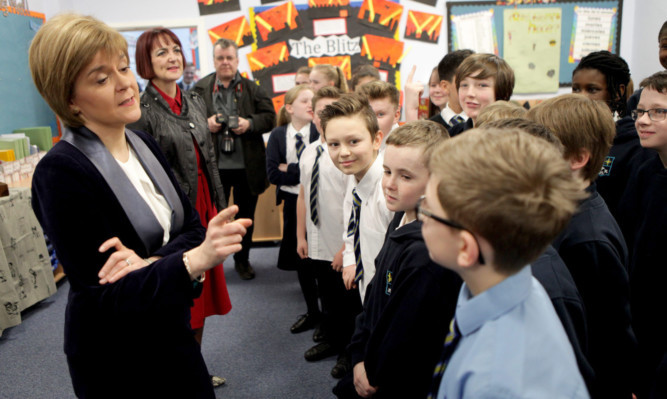There was one headline last week that had little to do with this election but should give every voter in Scotland pause for thought as they head to the polling booths on Thursday.
“Literacy standards decline in Scottish schools” it read, before laying bare the cold statistics that give the lie to Nationalist politicians’ boasts about ending austerity and speaking up for Scotland.
Between 2012 and 2014, the number of children performing well in school dropped dramatically, according to official figures released by Scotland’s chief statistician.
Less than half of S2 boys (47%) were doing well, very well or performing beyond the level they were being assessed for in writing, down from 58% in 2012.
The proportion of S2 girls whose writing was of the same standard also fell, from 70% to 63%. The proportion of both boys and girls performing well in reading has also plummeted.
In the most deprived communities, just two-fifths (41%) of S2 pupils were said to be performing well or very well in writing, a drop of 11 points in the past two years.
Education is a devolved matter, so the SNP, in power here since 2007, cannot blame anyone else for this marked deterioration in our schools. The widening of the attainment gap is a particularly damning indictment of a party that claims to put social justice first.
This is not the first time Scottish literacy rates, especially among poorer schoolchildren, have embarrassed an apparently left-wing administration that says “fairness and equality” are at its heart.
Education is the key to a fairer society, the stepping stone to a better life. From good schooling and sound qualifications come opportunity, aspiration and success.
Nationalist ministers would probably acknowledge this truth as much as those less progressive parties but unlike, say, the Conservatives or Liberal Democrats, who have prioritised education reform in the rest of the UK, the Nationalists have more important matters to worry about.
The fact that they have allowed teacher numbers to drop, class sizes to get bigger and spending on schools to decrease is because their focus is elsewhere.
Despite their election rhetoric, they remain a single-issue party and that issue is independence.
So, when you go to vote tomorrow, if you want an end to the United Kingdom as much as the SNP seems to do that is, above everything (equality, fairness, financial security, sound defences) you should vote for whichever separatist is standing in your constituency.
However, be absolutely sure that is what you want because, once elected, your Nationalist MP will have no other agenda than to break up Britain. Only the hopelessly nave can believe the SNP is contesting Westminster seats for any other reason.
If the party does find itself in a position to prop up a weak Labour regime, its goal, at the end of Labour’s five-year term, will not be to make Ed Miliband look statesmanlike, or to help put the UK’s economy in order, or to do anything that reflects well on Britain.
The idea that a stable government (Labour, Conservative or even another coalition) would be beneficial for Scotland, too, is completely lost on the secessionists.
Nicola Sturgeon may have toned down her stridency, hidden her republican tendencies and softened her image to win votes but her party is sending to Westminster a wrecking ball of MPs who make no secret of their desire for a second referendum.
She has also refused to rule this out, saying it will be for the people to decide.
However, by that she means her people, the 100,000-plus members of the SNP who will clamour at the party’s autumn conference for a rerun of last year’s ballot on independence.
If you want to put Scotland through that again, if you want the interminable introspection (because there is no indication the Nationalists, even if they have 50 MPs, would win a repeat poll), the bitter divisiveness that still pervades Scotland (just witness the ugly welcome protesters gave Eddie Izzard and Jim Murphy in Glasgow on Monday) and if you want our domestic services, from education to health, to be neglected for the foreseeable future, then vote with the Yes camp.
However, if you think Scotland speaks with more than one voice and that yours is not necessarily best represented by shrill separatists, vote for anyone but the SNP. Vote tactically if your party can’t beat the Nationalist candidate.
If you want Scotland to flourish, if you don’t want your taxes to rise to Norwegian scales to plug the gaping hole in the SNP’s sums (£7.6 billion at the last count), vote in the nation’s, not in the Nationalists’ interests.
